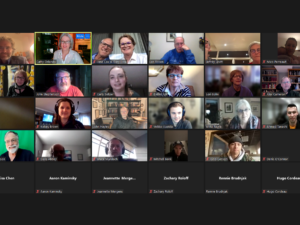–Posted May 8, 2017– By Tony Sirna California state Senators Bob Wieckowski and Kevin De León introduced a bill this week that would update the state’s 5-year-old cap and trade system to have some remarkable similarities to CCL’s Carbon Fee and Dividend. The bill would shift cap and trade starting in 2021 to include a steadily rising carbon price, a per capita dividend, and a border adjustment — all key elements of CCL’s proposal. The system is different though in a number of ways. Rather than a carbon tax, the system would be a simplified cap and trade system with a “price collar.” Emitters would no longer be able to use carbon offsets in lieu of purchasing allowances. The state would no longer distribute free emissions allowances, and allowances could not be banked from one year to the next. The state would set a steadily declining cap on emissions towards its target of 40% reductions by 2030 and 80% reductions by 2050, both below 1990 levels. Emission allowances would be auctioned off starting at a “floor” price that would begin at $20 in 2021, increasing by $5/year starting in 2023 plus inflation (current floor price is $13.57 and rises slowly at 5%/year). The price collar would include a “ceiling” price that would start at $30 in 2021 and increase by $10/year. Analysts at the California Air Resources Board expect emissions to remain lower than the cap due to other regulations and programs until the early 2020s. After that, many expect that the price would stay at the ceiling, essentially creating a carbon price that rose by $10/year covering 85% of California’s emissions (including motor fuel, electricity, natural gas, and industrial emissions). SB775 calls for revenue to be split between a Climate Dividend Fund and funds for research and infrastructure. The details of the split are not yet specified but news reports suggest that 60-90% of the funds would be directed to a quarterly per capita dividend for every resident of California. The cap and trade system is currently approved only through 2020 and Governor Jerry Brown has made it clear that he wants the legislature to approve an extension of the program before the end of June. California requires a two-thirds majority to approve any program that generates revenue for the state. Democrats currently hold two-thirds of the seats in both the Senate and Assembly. Cap and Trade has come under fire from environmental justice (EJ) groups in the state for not doing enough to address local air quality issues. In its current form, offsets and trading allow for large emitters to avoid reductions at little cost, which can create hotspots for harmful pollutants in disadvantaged communities. Many EJ groups have come out in support of SB775 as well as supporting other modifications to cap and trade that address local air quality more directly. The provision for a state-level border adjustment is a novel innovation that, while exciting, will certainly face some legal challenges. The bill’s authors believe that the provision does not violate the U.S. Constitution’s Commerce Clause, which grants power to regulate interstate commerce to the federal government. This question would not be resolved until the courts make a determination after the law is implemented. If the border adjustment were struck down, the bill would allow free allowances to be offered to emitters who are vulnerable to interstate competition. David Roberts at Vox provides an in depth analysis of SB775 and calls it “the most important advance in carbon-pricing policy in the US in a decade.” This policy shift would also have implications in Canada since Ontario and Quebec both have cap and trade systems that are linked with California’s. This would push them to align their systems with California, go it alone with their current cap and trade, or shift to a carbon tax. CCL is open to supporting state level carbon pricing policies that provide for greater emissions reductions than current law, protect low-income households, harmonize well with Carbon Fee and Dividend, and are politically viable for the state. We have not made an endorsement of SB775 but are following this effort closely. CCL volunteers interested in getting involved in supporting SB775 should look to working with Californians for a Carbon Tax (CalFACT), an organization set up by a handful CCL volunteers to work on California carbon pricing legislation. CCL has invited CalFACT to brief CCL volunteers in a webinar scheduled for Monday May 8th at 5pm Pacific (Join at https://citizensclimate.zoom.us/j/2017201717). BLOG: California bill to make cap and trade similar to Carbon Fee and Dividend
BLOG: California bill to make cap and trade similar to Carbon Fee and Dividend
Home » CCL Canada News » BLOG: California bill to make cap and trade similar to Carbon Fee and Dividend
BLOG: California bill to make cap and trade similar to Carbon Fee and Dividend
Posted on May 8, 2017 in Blog






